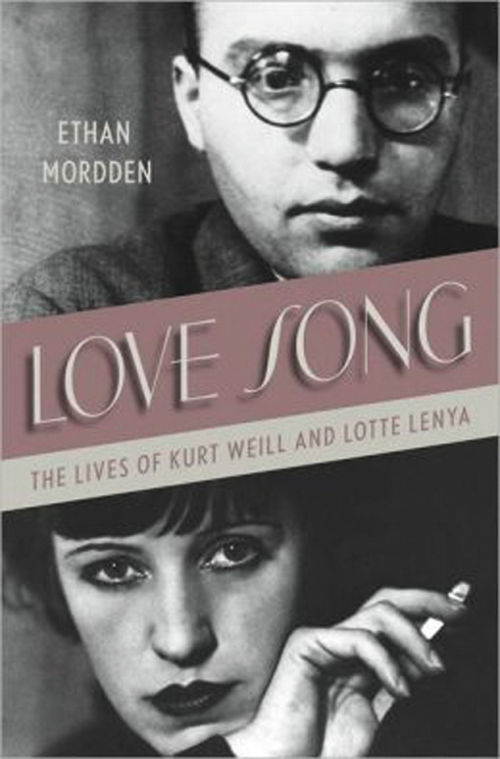Life of composer Kurt Weill is told in compelling ‘Love Song’
Published April 10, 2013
Author Ethan Mordenn, whose writings have appeared in The New Yorker, The Wall Street Journal, and The New York Times (he also penned a six-volume history of the American musical and a biography of Florence Ziegfield), has written a new dual biography, “Love Song, The Lives of Kurt and Lotte Lenya” (St. Martin’s Press, $29.99, 334 pages).
Composer Kurt Weill, the son of Albert Weill, a cantor, and Emma Ackerman, was born in Dessau, Germany, in 1900. His father introduced him to the piano, and by the time he was 12, he was already beginning to compose. He studied composition first with Engelbert Huperdinck and later with Ferrucio Busoni. While in Berlin studying with Busoni in 1926, Weill met Lotte Lenya, a young dancer and actress who was born Karoline Wilhelmine Charlotte Blamauer to working class Catholic parents in Vienna. They married in 1928.
Weill’s early works were similar to those of earlier musical giants, but eventually he began to evolve his own style. Most influential in helping Weill transform his operatic works from the past to the social interests of the present would be his future collaborator, the noted poet, Bertolt Brecht. The best known operatic work of Bertolt and Weill is “Die Dreigroschenoper,” a reworking of John Gay’s “The Beggar’s Opera” from 1728. The Bertolt-Weill opera, re-named “The Threepenny Opera,” was widely received, and contained Weill’s most popular ballad “Mack the Knife.” In 1931 a motion picture version of the opera was filmed which helped spread Weill’s fame across the European continent. Lotte Lenya played the lead role of Jenny.
Weill and Lenya separated in 1932 and divorced in 1933, but they remained on friendly terms. As a prominent and popular composer, because of his Judaism, Weill was officially denounced for his political views and became a target of the Nazi authorities. Like many of his con temporary intellectual and cultural friends, Weill fled Nazi Germany in 1933, first to Paris and then the United States in 1935 (he was accompanied by Lenya, whom he would remarry in 1937).
When he arrived in America, Weill attempted to establish and redirect his career to meet the demands of the Broadway musical theater. At the same time, he insisted on defining his work differently from established composers such as George Gershwin, Cole Porter and Richard Rodgers.
The shows “Knickerbocker Holiday”(1938) and “Lady in the Dark” (1941 — a collaboration with lyricist Ira Gershwin with a book by Moss Hart, and starring Gertrude Lawrence and Danny Kaye) pushed Weill to the forefront of Broadway composers. During the following decade he stood out not only as a Broadway great, musical composers, but also as a composer for films, opera and the recording industry.
Weill suffered a heart attack shortly after his 50th birthday and died on April 3, 1950, in New York. After Weill’s death, his widow, Lenya, was coaxed backed to the Broadway stage and later married influential American editor George Davis. In 1956 she won a Tony Award for her role as Jenny in the English version of “Threepenny Opera.” In 1961 she was nominated for an Academy Award nomination as Best Supporting Actress in Tennessee Williams’ screen version of “The Roman Spring of Mrs. Stone. “ In 1963 she was cast as the SPECTRE agent Rosa Klebb in the James Bond movie “From Russia With Love.” In 1966 Lenya originated the role of Fraulein Schneider in the original Broadway cast of the musical “Cabaret.” After the death of her second husband in 1957, she married the artist Russell Detwiler in 1962. He was 26 years her junior, but died at the age 44 in 1969. Lenya died in New York City of cancer in 1981, aged 83, and was buried next to Weill in Haverstraw, N. Y.
Mordenn’s book is not without its merits. He gives the reader a 20-page discography, describing in detail the bulk (he says selective, not complete) of Weill’s work, including many of Lotte’s renditions of his works, including 78s, CDs and DVDs. The author also includes a carefully annotated bibliography of other biographies of Weill and Lenya, as well as a number of monographs dealing with both Berlin and Germany covering the period in which Weill and his wife lived.
Mordenn clearly explains why Weill was forced to leave Germany. He details why the Nazis found Weill’s works objectionable, especially those which the Germans called depraved.
The book is not, however, without its faults. There are no footnotes to show the reader the sources of Mordden’s material. The book is, supposedly, a dual biography of both Weill and Lenya, but the bulk of the material deals with Weill, and even there, too much of the book focuses on Weill’s colleagues and not enough on Weill. We know his father was a cantor. How much influence did that have on Weill? The author states briefly that Weill was born into a “strong Jewish household,” but that is the extent the reader knows about Weill’s religiosity. The reader is told that Weill was married twice to Lotte Lenya, but the author spends very little time discussing more personally the relationship between the couple.
In a book of only 334 pages, it seems that the author attempted to “cram” in so much material that he failed to inform the reader what Weill and Lenya were really like. The author is much more perceptive as a critic than a biographer. Mordden cited in his bibliography “Speak Low (When You Speak Love): The Letters of Kurt Weill and Lotte Lenya,” edited and translated by Lys Symonette and Kim Kowalke (University of California, 1996). To find more penetrating information about Weill and Lenya, this might be a better place to begin.















